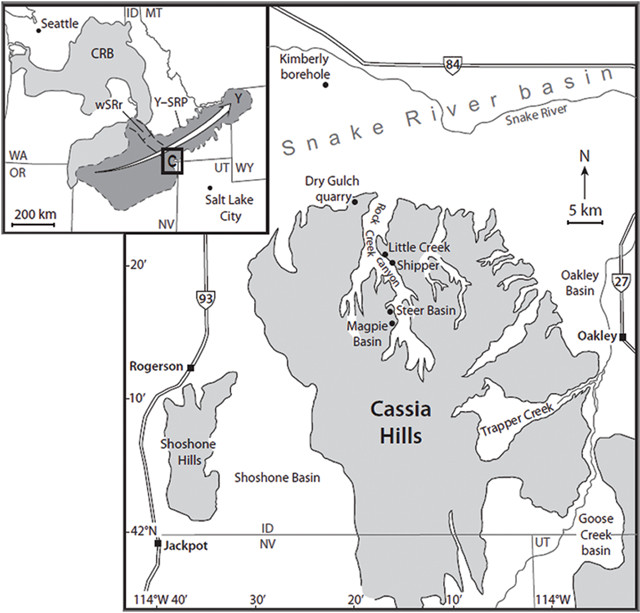
by Kate S. Zalzal Thursday, July 14, 2016

In the Cassia Hills in southern Idaho, researchers found evidence of a dozen large eruptions from the Yellowstone hot spot volcanic system that occurred between about 11.3 million and 8 million years ago. Credit: Knott et al., GSA Bulletin, March 2016.
About 8 million years ago, what is now the Snake River Plain of southern Idaho ripped open in a catastrophic super-eruption that spewed roughly 1,900 cubic kilometers of lava and ash across thousands of square kilometers. New research, based on field studies and geochemical analyses of rocks collected on the plain, shows that this eruption was just one of many massive mid-Miocene volcanic events arising from the Yellowstone hot spot. The work also provides a window into the complex and evolving mantle-crust interactions that have occurred as the North American Plate has moved westward over the hot spot.
The Yellowstone-Snake River Plain volcanic province has long been a focus of research due to its position above the proposed intraplate hot spot, its frequent and voluminous eruptions, and the unusual chemistry of the materials erupted. However, the number and size of eruptions, the physical mechanisms behind these eruptions, and their distinct isotopic signatures remain poorly understood.
Scientists had previously described broad eruption relationships in the Yellowstone-Snake River Plain based on known units of rhyolitic magma, “but we wanted to try to constrain precise, individual eruption layers,” says Thomas Knott, a geochemist at the University of Leicester in England and lead author of the new study, published in the Geological Society of America Bulletin. Rhyolitic magma is enriched in silica, contains more water and gas, and is more viscous than basalt and most other magmas; the combination of high viscosity and volatile concentrations contributes to the explosivity of rhyolitic eruptions.
Knott and his team collected samples of ancient lavas from incised canyons and from a new borehole near the Cassia Hills of southern Idaho. After analyzing the samples to characterize the rocks’ chemistry and geochronologic and paleomagnetic signatures, and correlating the fallout from different eruptions across large distances, the team identified evidence for 12 explosive rhyolitic eruptions that took place in the vicinity of the hills between about 11.3 million and 8 million years ago. That reduces the number of eruptions thought to have occurred from the Yellowstone hot spot in the mid-Miocene.
Although there might have been fewer eruptions, the work “highlights that these eruptions may have been much larger than previously thought,” says Ben Ellis, a volcanologist at ETH Zürich in Switzerland who was not involved with the study.
With the refined eruption stratigraphy in place, Knott and his team considered questions regarding large-scale magmatic dynamics unique to this type of intraplate volcanism. Studying the major- and trace-element geochemistry of the deposits, they identified three successive cyclic trends characterized by high-silica magmas becoming progressively less silica-rich. This changing geochemistry “gives us a wonderful window into the structure of a thick continental plate and how it interacts with a hot spot … we don’t really get that information in this detail anywhere else on the globe,” Knott says.
At the beginning of a cycle, Knott explains, “the hot spot brings up the mantle basalts and, importantly, provides the thermal energy needed to heat and melt the crust, which creates the more silica-rich melts.” As these early melts cool in upper crustal reservoirs, silica-poor minerals that crystallize at higher temperatures form — a process called crystal fractionation — leaving the remaining liquid magma rhyolitic in composition and enriched in silica. As the system progresses, fractionation in the crustal reservoirs slows and new injections of mantle-derived basalts mix with the rhyolitic melt and dilute its silica content. The system resets when the tectonic motion of the North American Plate redirects flow from the hot spot into fresh silica-rich crust.
Similar melt evolution cycles are well preserved in the present-day Yellowstone system, so there “may be a recurrent theme in these large volcanoes,” Ellis says. Additional study of the extent and geochemistry of these ancient lavas — including the signatures of radiogenic isotopes in them, for example — could offer added insight, he says. “There is the potential for the Yellowstone hot spot track to reveal even more huge eruptions,” Ellis says, “and the ability to characterize a unit to this level of detail is extremely important.”
Knott says the current work highlights how eruption geochemistry is intrinsically linked with the evolving structure of the crust. The large volumes of volcanic material produced and brought to the surface potentially thinned and loaded the Snake River Basin, causing it to subside, meaning these eruptions were “fundamentally changing the structure of the crust at the same time they were interacting with it,” he says.
© 2008-2021. All rights reserved. Any copying, redistribution or retransmission of any of the contents of this service without the expressed written permission of the American Geosciences Institute is expressly prohibited. Click here for all copyright requests.